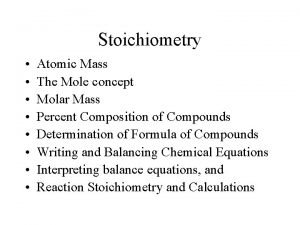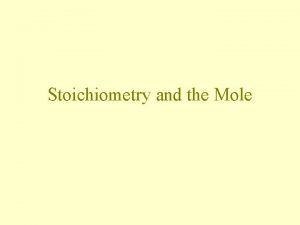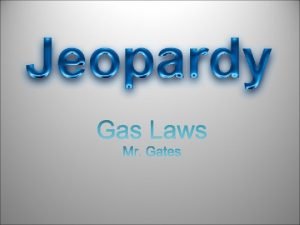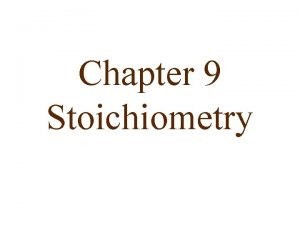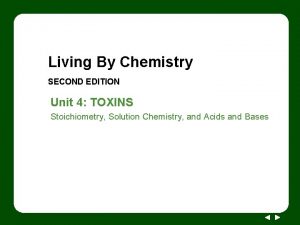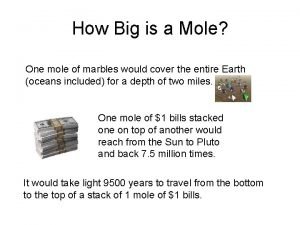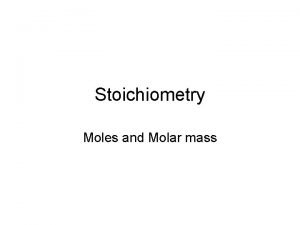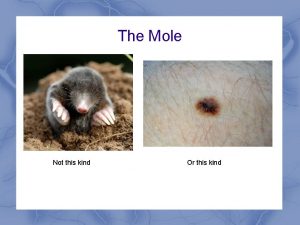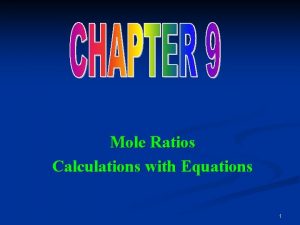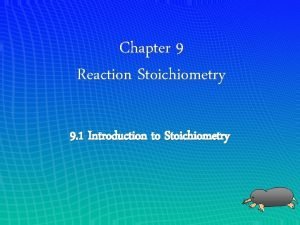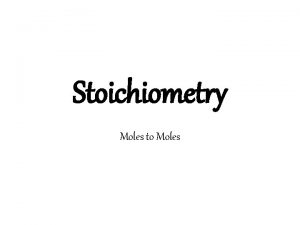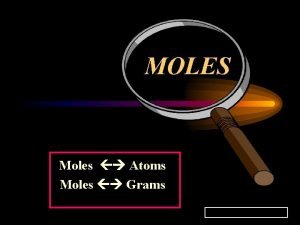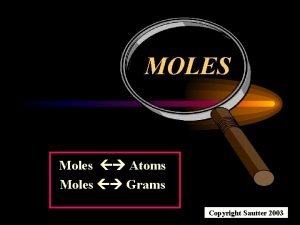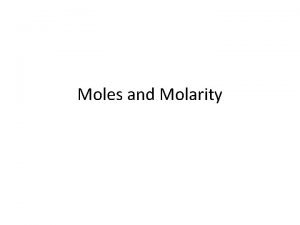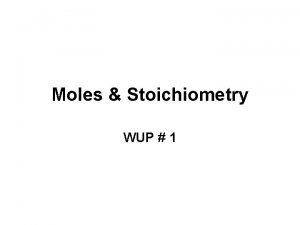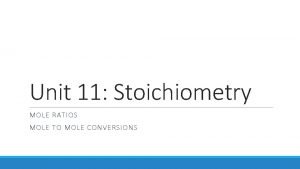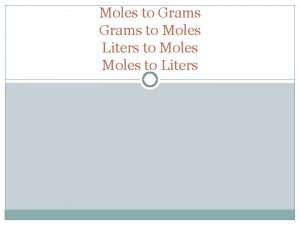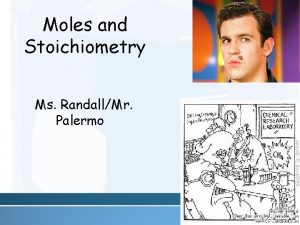STOICHIOMETRY LETS REVIEW MOLES AND PARTICLES 1 mole


















- Slides: 18

STOICHIOMETRY

LETS REVIEW- MOLES AND PARTICLES 1 mole = 6. 022 x 1023 particles (formula units/ molecules/atoms) Moles Multiply by 6. 022 x 1023 Particles Divide by 6. 022 x 1023 Moles Particles

ANOTHER WAY TO LOOK AT IT: N = n x NA N = Number of particles (molecules, formula units, atoms) n = amount (in mol) NA = Avagadro constant (mol-1)

FOR EXAMPLE N = n x NA A sample contains 1. 25 mol of nitrogen dioxide. � How many molecules are in the sample? Molecules of NO 2 = 1. 25 mol x (6. 022 x 1023 molecules/mol) = 7. 52 x 1023 molecules � How many atoms are in the sample? There is 1 atom of nitrogen and 2 atoms of oxygen in every molecule of NO 2 7. 52 x 1023 molecules x (3 atoms/ molecule) = 2. 26 x 10 24 atoms in 1. 25 mol of NO 2

LETS REVIEW- MOLAR MASS A mole of an element has a mass in grams that is numerically equivalent to the elements average atomic mass. Molar Mass (M)= mass of one mole of a substance (g/mol) � Molar mass of an element can be found by looking at the periodic table � Molar mass of a compound can be found by totalling the mass of all elements in the compound What is the molar mass of beryllium oxide? MBe. O = MBe + MO = 9. 01 g/mol + 16. 00 g/mol =25. 01 g/mol

PARTICLES TO MASS What is the mass of 0. 750 mol of CO 2 gas? Divide by 6. 022 x 1023 Multiply by M Mass Moles Particles Multiply by 6. 022 x 1023 Divide by M 1. MCO 2 = 2 x (16. 00 g/mol) + 12. 01 g/mol = 44. 01 g/mol 2. m = (0. 750 mol)(44. 01 g/mol) = 33. 0 g

PARTICLES TO MASS How many molecules of iodine chloride, ICl, are in a 2. 74 x 10 -1 g sample? Multiply by M Divide by 6. 022 x 1023 Mass Moles Particles Multiply by 6. 022 x 1023 Divide by M 1. MICl =126. 90 g/mol + 35. 45 g/mol = 162. 36 g/mol 2. n = (2. 74 x 10 -1 g)/(162. 36 g/mol) = 1. 69 x 10 -3 mol 3. (1. 69 x 10 -3 mol)(6. 022 x 1023 molecules/mol) = 1. 01 x 1021 molecules

MOLAR VOLUME

PRESSURE What is pressure? � Collisions � Depend on: Temperature Volume � PV=n. RT

STANDARD TEMPERATURE AND PRESSURE Since V depends on P and T, you must state both when describing a gases V. STP: � Average atmospheric pressure at sea level (101. 3 k. Pa) � Freezing point of water (Oo. C, 273 K)

MOLAR VOLUME Joseph Louis Gay-Lussac (1778 -1853) � Law of combining volumes: when gases react the volume of reactants and products (measured at equal T and P) are always whole number ratios + 2 L H 2 1 L O 2 2 L H 2 O

MOLAR VOLUME Amedeo Avogadro (1776 -1856) � Realized he could relate the volume of a gas to the amount that was present (from mass) Avogadro’s Hypothesis: equal volumes of all ideal gases at the same temperature and pressure contain the same number of molecules In other words: 1 mole of any gas has the same volume as 1 mole of any other gas at STP.

MOLAR VOLUME

THOUGHT LAB- MOLAR VOLUME OF GASES Two students in a lab decided to calulate the molar volume of carbon dioxide, oxygen and methane gas. They measured the mass of an empty, 150 m. L syringe and then the mass of the syringe + gas. They repeated this procedure for each gas. The experiment was carried out in a room maintained at STP (273 K and 101. 3 k. Pa). Their results are in the table on the next slide:

THOUGHT LAB- MOLAR VOLUME OF GASES Gas: Carbon Dioxide Oxygen Methane Volume of gas (V) 150 m. L Mass empty syringe 25. 081 g 25. 085 g 25. 082 g Mass gas + syringe 25. 383 g 25. 304 g 25. 197 g Mass of gas (m) Molar mass of gas (M) Number of moles of gas (n = m/M) Molar Volume of gas at STP (V/n)

MOLAR VOLUME It turns out that the molar volume of any gas at STP is 22. 4 L/mol! Well, actually, that’s not entirely true…. � The molar volume of 22. 4 L/mol is assumed for ideal gases- which are hypothetical gases that don’t take up space and do not attract one another � Real gases do take up space and attract each other somewhat- so the molar volume would vary slightly from 22. 4 L/mol…. but it’s close � We will always assume the molar volume of a gas is 22. 4 L/mol at STP!

EXAMPLE: What is the volume of 3. 0 mol of nitrogen dioxide gas at STP?

TRY THIS: Suppose you have 44. 8 L of methane gas at STP. � 1. How many moles are present? � 2. What is the mass of the gas? � 3. How many molecules of the gas is present?
 Gram to gram conversion
Gram to gram conversion Stoichiometry worksheet #2 (mole-mass mass-mole problems)
Stoichiometry worksheet #2 (mole-mass mass-mole problems) Phosphorus and oxygen equation
Phosphorus and oxygen equation Stoichiometry mole-mole
Stoichiometry mole-mole Ideal gas law powerpoint
Ideal gas law powerpoint Grams mass
Grams mass Mole-mass-volume relationships
Mole-mass-volume relationships Stoichiometry grams to moles
Stoichiometry grams to moles Stoichiometry mole island diagram
Stoichiometry mole island diagram Mole tunnel stoichiometry
Mole tunnel stoichiometry Mole conversion chart
Mole conversion chart Mol island
Mol island Xkcd mole of moles
Xkcd mole of moles Mole-mole factor
Mole-mole factor Lets review cartoon
Lets review cartoon Definition of integer
Definition of integer Let's have a review
Let's have a review Chapter 9 review stoichiometry modern chemistry answers
Chapter 9 review stoichiometry modern chemistry answers Chapter 9 review stoichiometry section 1
Chapter 9 review stoichiometry section 1


